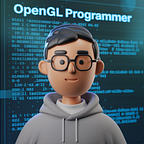Understanding the OpenGL Pipeline: A Beginner’s Guide
Welcome back to our journey into the world of OpenGL! In this post, we’ll take a closer look at something called the “OpenGL Pipeline.” But don’t worry — it’s not as complicated as it sounds. Think of it as a series of steps that your computer goes through to draw all the cool stuff you see on your screen.
What is the OpenGL Pipeline?
Imagine you’re making a sandwich. You don’t just toss all the ingredients together at once. First, you lay down the bread, then you add the cheese, the ham, and finally the other slice of bread. The OpenGL pipeline works in a similar way, except instead of making a sandwich, it’s making pictures.
The pipeline is like a factory that takes in simple shapes and turns them into the images you see on your screen. It does this in several steps, which we’ll go through one by one.
Step 1: Vertex Processing
The first step in the pipeline is called Vertex Processing. Vertices (singular: vertex) are like dots that make up the corners of your shapes. For example, if you’re drawing a triangle, it has three vertices. In this step, OpenGL figures out where these vertices should be on your screen.
Think of it like plotting points on a graph in math class. The computer needs to know exactly where to place these points to start forming your picture.
Step 2: Shape Assembly
Once the vertices are in place, OpenGL starts connecting the dots. This step is called Shape Assembly. It’s like when you connect dots on paper to make a picture. The vertices are connected to form lines, triangles, or other shapes.
For example, if you have three vertices, OpenGL will connect them to make a triangle. This is how your simple dots start to form recognizable shapes.
Step 3: Rasterization
Now that your shapes are ready, OpenGL needs to figure out which pixels on your screen should be colored to make those shapes visible. This step is called Rasterization.
Imagine you’re coloring in a picture. Rasterization is the process of filling in the shapes with color so that they appear on your screen. OpenGL decides which pixels (the tiny dots that make up your screen) should be colored and what color they should be.
Step 4: Fragment Processing
After the shapes are filled in with color, there’s one more step before the image appears on your screen. This step is called Fragment Processing.
Fragments are like the pixels of your shape, but they haven’t been finalized yet. In this step, OpenGL can add effects like lighting and shadows to make your shapes look more realistic. It’s like adding the final touches to your drawing, making sure everything looks just right.
Step 5: Displaying the Image
Finally, after all the processing is done, the image is ready to be displayed on your screen. The computer takes all the work it’s done — placing vertices, assembling shapes, rasterizing, and processing fragments — and puts it all together to show you the final picture.
Why Does This Matter?
Understanding the OpenGL pipeline is important because it helps you know how your computer turns simple commands into the complex images you see in games, apps, and other programs. Each step is like a building block that comes together to create something awesome.
Conclusion
The OpenGL pipeline might sound a bit tricky at first, but remember, it’s just a series of steps that your computer follows to draw images. By learning how these steps work, you’ll get a better understanding of how to create your own amazing graphics with OpenGL.
So, keep experimenting, keep coding, and soon enough, you’ll be creating stunning visuals just like the pros!
Related Posts:
- Creating Your First OpenGL Scene: Drawing Primitives in C++
- Animating Your OpenGL Scene: Basic Movement and Rotation
- Using OpenGL’s Depth Buffer for 3D Rendering
- Transformation in OpenGL: Translation, Rotation and Scaling
- Handling Input in OpenGL: Keyboard and Mouse Controls
- Camera System in OpenGL with Perspective Projection
- Texture Mapping: Applying Textures to a Cube in OpenGL
